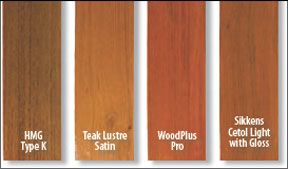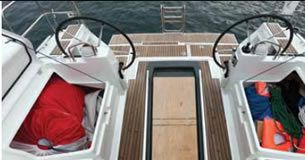The marine environment can be incredibly harsh on a sailboats exterior wood, and protecting it is a never-ending project. So weve embarked on a mission to find the best wood protection: The ideal exterior wood coating is fast, easy to apply and maintain, durable, and wont break the bank. This first article in the wood coatings series focuses on marine varnishes, specifically 18 one-part varnishes, their ease of application, and their original gloss. Well introduce three two-part varnishes and 19 various teak treatments being tested in subsequent articles. We tested the best known brands of marine products as well as a few off the shelves of the local hardware store, including those from Epifanes, Interlux, Pettit, Detco, Deks Olje, Minwax, HMG, and West Marine. Determining which type of exterior wood coating is best for your boat boils down to identifying your priorities, needs, and taste. Do you want high-gloss or matte finish? Are you a low maintenance-type of owner or are you willing to spend as much time sanding as sailing?
****

As reader letters regularly point out, the hunt for the ideal wood coating is never ending, much like the chore of maintaining it. And because its been a few years since
Practical Sailor popped the top on them, weve launched a new round of testing to find the best looking, most durable exterior wood finish.
Most of our past reviews focused strictly on varnishes or strictly on teak treatments. In 2003, we took the top finishers in each category and tested them for an all-stars roundup to determine our overall favorites for appearance and longevity. (The results were published in the Feb. 15, 2005 issue: Epifanes High Gloss got the nod among glossy finishes, and Sikkens Cetol topped other matte finishes.) With this evaluation, were going for both the apples-to-apples comparison our single-category tests afforded and the apples-to-oranges comparison the 2003 all-star test offered.
With 39 products in the running – 18 one-part varnishes, three two-part varnishes, and 18 “teak treatments” – and more likely to be added, the data can be overwhelming. To avoid making the world of wood finishes more complicated than necessary, well present the products and results by category, but will test them together to ensure that they face the same conditions. This article – the first of several reports – focuses on one-part varnishes, their ease of application, and their original gloss. Well introduce the two-part varnishes and various teak treatments being tested in subsequent articles. Weve included the best known brands of marine products as well as a few off the shelves of the local hardware store.

Determining which type of exterior wood coating is best for your boat boils down to identifying your priorities, needs, and taste. Do you want high-gloss or matte finish? Are you a low maintenance-type of owner or are you willing to spend as much time sanding as sailing?
In our opinion, the ideal exterior wood coating is fast and easy to apply for even the novice brightwork nurse, and it is easy to maintain, lasts for multiple seasons, and wont break the bank.
Varnish
Varnish is a transparent, hard coating. It gives wood a traditional, natural look by allowing its true color to shine through. It doesn’t penetrate as far into the wood as other finishes, but it offers good protection due to its hardness. It tends to last the longest (multiple seasons), but is the most work to apply (many coats and much sanding).
Varnish has five main ingredients: oil, resin, solvent, dryers, and additives. And it is broken into four groups, depending on its base: alkyd, polyurethane, latex, or phenolic.
Varnishes with modified phenolics are expensive, but usually deliver top-notch durability. They neutralize oxidation, but tend to yellow fairly quickly. Oil, polyurethane, and epoxy varnishes cure quickly but tend to remain liquid even after evaporation of the solvent, going through stages of drying, from liquid to gummy, to tacky, to hard.
Alkyd varnishes are rather flexible but oxidize quickly outdoors. As resin varnishes dry, the solvent evaporates, and the coating hardens almost immediately. Acrylic and waterborne varnishes have a longer curing period; they “dry” when the water evaporates.
Thick polyurethanes typically offer less wood penetration than oil-based varnishes, because they harden faster. However, some makers slow the process by using thinning additives that allow the coating to seep further into the wood. Polyurethanes are prone to delamination or oxidation when subjected to heat.

The additives in varnishes and all wood coatings have specific functions: Flatteners result in a matte finish; other additives reflect the sun for UV protection, reduce oxidation, or inhibit cracking.
Most of the finishes we tested are one-part coatings, but, there are a few two-part systems, such as Interluxs Perfection. Once the two parts are mixed, the product has a limited “pot life,” or working time. They require more application effort, but are generally regarded as being more durable than single-parts.
Other Wood Finishes
Wood oils, stains, and synthetic coatings are more flexible than varnish and will not crack or peel. Their main appeal – and the impetus behind their rise in popularity – is that they are easy to apply, requiring fewer coats than varnish, and little or no sanding between coats.
Oils dry fast and penetrate deep into the wood, but they lack the hard protection of varnish. Several coats of oil will typically offer about six months protection. Some oils have a sheen to them, but most do not have that glossy, classic look of varnish or some synthetic applications, like Sikkens Cetol or West Marines WoodPro Plus. The oils are good coatings for areas where “Slippery When Wet” coatings can be dangerous. Matte-finish synthetics like Cetol and WoodPro Plus, applied without their gloss overcoat, are also good for these areas.
Oils range in color from clear to dark brown. Many synthetic finishes have added pigments that can turn the wood red, yellow, or an opaque brown. Some, like Deks Olje and Cetol, are considered varnish alternatives as they combine an oil-based bottom coat and a glossy sealer coat to offer the deep penetration of an oil and a hard top layer like a varnish.
How We Tested
The focus of this test is to evaluate three things: a products ease of application; the integrity of its gloss and appearance; and how it fares over time under real world conditions.
Testers cut dozens of 4 x 1-inch panels from the same bare teak. Each product and each panel were assigned a number so that judging could be done blindly. We coated each panel on all sides with its corresponding, numbered test product.
The panels were prepared and the coatings applied per manufacturers instructions. When a range was given for the number of coats to apply, we went with the minimum. Three
Practical Sailor testers evaluated and rated the original gloss of each panel. The next step will be to mount the panels on a rack and set the rack at a 45-degree angle in an unobstructed area outside.
Conclusions
Based solely on original gloss and initial appearance, testers picks so far for one-part varnishes are Interluxs Jet Speed Varnish; Epifanes Clear High Gloss and Wood Finish Gloss; Pettits Bak V-Spar 2053 and 2015 Flagship; and West Marines Five-Star Premium, which is a rebranded Epifanes High Gloss. Stay tuned to see which products still look good at six months and longer.
No matter which coating you go with, the key to a durable, good-looking finish is proper preparation. For free tips on application, visit
www.practical-sailor.com, select “Tools and Techniques,” and click on “Sparkling Brightwork: Careful Attention to the Details.”








































